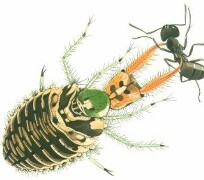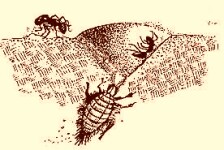 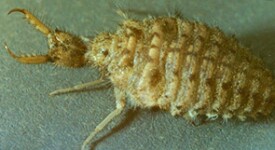 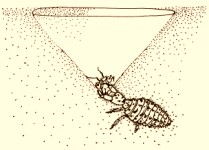 The ant lion larva eats ants and other insects. Some species hide under leaves or bits of wood, and attack passing insects. In sandy regions, some ant lion larvae dig a shallow cone-shaped pit and wait at the bottom for an insect to slip on the loose sand and fall in. When this happens, the ant lion eats the insect. These pit-digging ant lions are called "doodlebugs" in the United States because of the wandering designs they make in the sand while looking for the ideal spot to dig a pit. When it finally finds the right place, the 'doodlebug' makes circles in the sand with its head, each deeper than the last, until its pit is excavated. Then it buries itself at the bottom with only its head, with jaws open, can be seen, and waits for its prey. 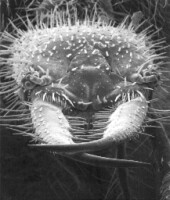  When an insect falls into the pit and struggles to escape, the ant lion flicks grains of sand at it. These cause more sand to slide to the bottom of the pit, sweeping the insect down to the bottom. The ant lion's jaws close on it, and pull the insect underground.
When an insect falls into the pit and struggles to escape, the ant lion flicks grains of sand at it. These cause more sand to slide to the bottom of the pit, sweeping the insect down to the bottom. The ant lion's jaws close on it, and pull the insect underground.Digestive juices and a toxin are then injected into the prey, liquefying everything but the exoskeleton. After sucking out the insect's insides, the ant lion tosses the remains from the pit. If small objects like pebbles or bits of leaf fall into the pit, the ant lion will try to clear them away. After a rainy or windy day, the ant lion often needs to rebuild its pit. If it doesn't catch enough prey in its trap, the ant lion will abandon it and move to another location.  Adult ant lions resemble dragonflies or damselflies, but are weak fliers; they are rarely seen because they are active only in the
evening. During the day they rest, motionless, well-camouflaged by their
transparent wings and brownish body. Adults do not feed on ants. They drink nectar, eat pollen or may
not eat anything at all. After mating, the female ant lion lays her eggs in soft dry sand; when
the eggs hatch, the larvae will build pits and start eating ants and other insects. Ant lion larvae eventually pupate in the soil, becoming adult insects. Adult ant lions resemble dragonflies or damselflies, but are weak fliers; they are rarely seen because they are active only in the
evening. During the day they rest, motionless, well-camouflaged by their
transparent wings and brownish body. Adults do not feed on ants. They drink nectar, eat pollen or may
not eat anything at all. After mating, the female ant lion lays her eggs in soft dry sand; when
the eggs hatch, the larvae will build pits and start eating ants and other insects. Ant lion larvae eventually pupate in the soil, becoming adult insects.In North America, adult ant lions are approximately 4 cm long and have a wingspan of 8 cm; fully developed larvae are as long as a human fingernail, about 1.5 cm. Antlions are a family of insects with the classification Myrmeleontidae. The name is from the Greek words 'myrmex' (ant) and 'leon' (lion). Here is the complete classification for the ant lion:

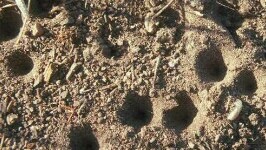 |
